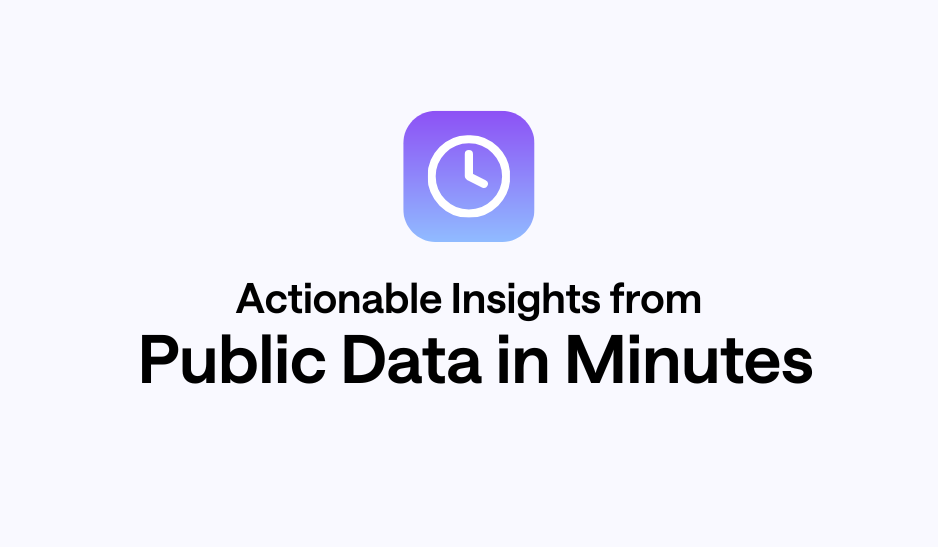How to Use Public Data for Strategic Workforce Planning
Strategic workforce planning requires a clear understanding of the labor market. For decades, accessing the data necessary for this analysis has been a significant challenge for businesses. It often involves purchasing expensive, proprietary reports or hiring specialized consultants, leading to slow, costly decision-making.
The reality is that a vast amount of valuable workforce data is publicly available through government bodies like the U.S. Census Bureau. The primary obstacle has been the difficulty in accessing and analyzing this raw data. Today, that barrier is being removed. New platforms allow business professionals to query these extensive datasets in plain English, enabling a more direct and efficient approach to workforce planning.
The Challenge of Modern Workforce Planning
Organizations currently face a difficult operating environment characterized by skills shortages, high employee turnover, and significant shifts in workplace dynamics. Yet, many businesses continue to rely on intuition or outdated information for their workforce strategy.
The core of the problem is twofold:
-
High Cost and Complexity: Traditional labor market analysis is expensive. Subscriptions to private data services can cost tens of thousands of dollars annually. Furthermore, the data is often delivered in formats that require data scientists or analysts with SQL proficiency to interpret, creating a bottleneck for business leaders who need immediate answers.
-
Lack of Timeliness: By the time a comprehensive workforce study is commissioned and completed, the market conditions may have already changed. In a volatile economic climate, the ability to assess the current labor landscape quickly is essential for maintaining a competitive advantage.
These challenges are amplified by the need to make decisions about remote work policies, geographic expansion, and talent retention. Without accessible data, businesses are planning in the dark.
Using Public Data for Workforce Planning Analysis
A substantial repository of workforce information is available at no cost through U.S. government sources. The most critical dataset for state-level analysis is the U.S. Census Bureau's American Community Survey (ACS).
The ACS is a nationwide survey that collects social, economic, housing, and demographic information annually. It is an indispensable resource for workforce planning because it provides detailed data on:
-
Occupations and Industries: This is about how many people work in specific job categories. For example, "Computer and Mathematical Occupations" is one category. Another example is industries like "Professional, Scientific, and Technical Services."
-
Educational Attainment: The percentage of the population with high school diplomas, bachelor's degrees, or graduate degrees.
-
Median Earnings: Income data for different occupations and demographics.
-
Labor Force Status: Information on employment, unemployment, and labor force participation rates.
This is where Cambium AI provides a direct solution. Instead of downloading large data files and attempting to cross-reference them in spreadsheets, users can ask questions in natural language. For instance, a management consultant can ask, "What is the average income for business analysts in Texas versus Florida?" Cambium AI queries the relevant datasets and generates a comparison chart in seconds.
Practical Applications for Strategic Decisions
Accessing public data through a no-code interface allows leaders to address several key business challenges with current, reliable information.
Use Case 1
Site Selection and Expansion
A technology firm is planning to open a new development hub. The executive team needs to identify states with a healthy talent pool of software developers and a reasonable cost structure. Using Cambium AI, a business analyst could ask:
-
"Show me the states with the highest number of workers in computer and mathematical occupations."
-
"Compare the median earnings for software developers in Arizona, North Carolina, and Colorado."
-
"What is the percentage of the population with a bachelor's degree or higher in those states?"
These queries provide immediate, quantifiable information to support a data-informed site selection process, reducing research time from weeks to minutes.
Use Case 2
Talent Acquisition Strategy
A healthcare organization is struggling to hire registered nurses. Its HR team needs to refine its recruitment strategy and ensure its compensation is competitive. An HR manager could ask:
-
"Which states have the highest concentration of registered nurses?"
-
"What are the median earnings for registered nurses in Illinois?"
This allows the team to target recruitment efforts in states with a larger supply of qualified professionals and to benchmark their compensation packages against income data from the ACS, helping to improve both talent acquisition and retention.
Use Case 3
Skills Gap Analysis
A public policy professional is researching the availability of renewable energy technicians to support a new state-level green energy initiative. They need to understand the current labor market for these specific skills. They could use Cambium AI to query the data for the number of people in related occupational categories, like "Architecture and Engineering Occupations," within that area. This provides a baseline understanding of the existing workforce and helps identify potential skills gaps that may need to be addressed through training programs or educational partnerships.
A Step-by-Step Guide to Workforce Analysis with Public Data
Making public data actionable does not require a technical background. The process is straightforward and focuses on the business question, not the data itself.
-
Define Your Question:
Start with the specific business challenge. Are you trying to determine where to find specific talent? Do you need to benchmark salaries? Are you assessing the educational attainment of a regional workforce? A clear question is the most important step.
-
Identify the Relevant Data Points:
Consider what information you need. Is it income data, employment numbers for a specific occupation, or demographic details? You do not need to know the specific ACS table; the query itself will identify the required information.
-
Query the Data in Plain English:
Phrase your question as a direct query. For example: "Show me a bar chart of the number of people employed in the manufacturing sector in Ohio, Michigan, and Indiana for the most recent year."
-
Visualize and Interpret the Results:
Cambium AI presents the results as a chart or map, providing an immediate visual answer to your question. This visualization makes it simple to interpret the data and apply it to your strategic plan. The result is a clear view of the current state of the workforce, enabling more confident and timely decisions.
-1.png?width=3200&height=2400&name=In%20Post%20Blog%20Images%20(6)-1.png)
Conclusion
Strategic workforce planning should be a dynamic, ongoing process informed by current data. Historically, the cost and complexity of labor market analysis have made this difficult to achieve. By utilizing accurate, publicly available data, organizations can gain a significant analytical advantage.
The key is to have the right tools to access and interpret this information without needing a team of data experts. Cambium AI allows professionals across all business functions—from marketing and finance to human resources and operations—to query vast public datasets and receive instant, actionable insights. This approach reduces costs, accelerates research, and enables organizations to make more precise, evidence-based decisions about their most valuable asset: their people.
To see how Cambium AI can streamline your research process, start your 7-day free trial.


.png)
